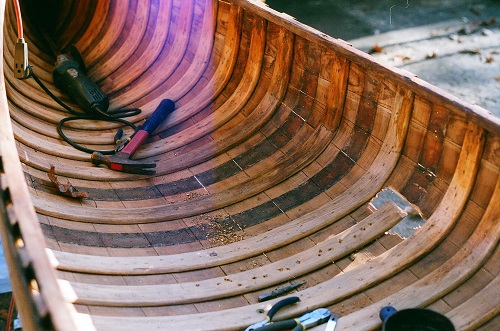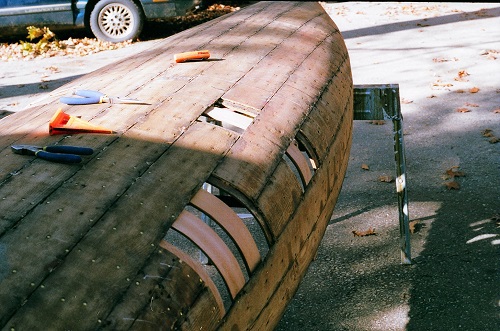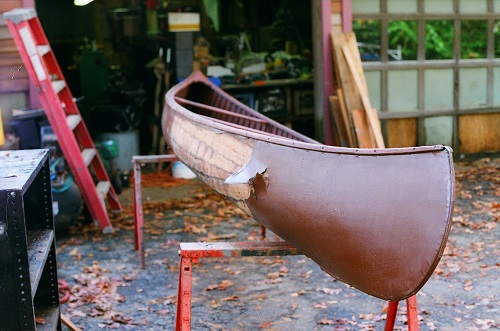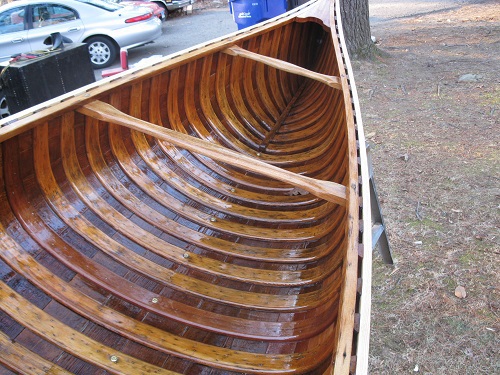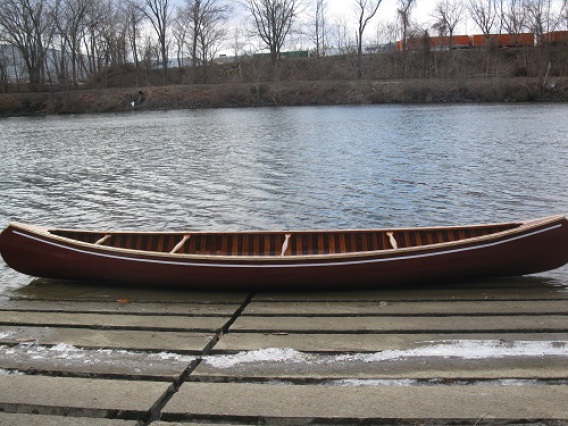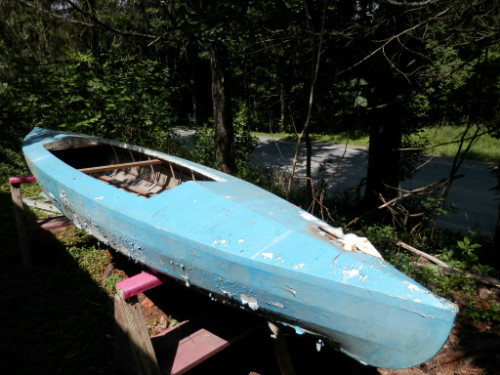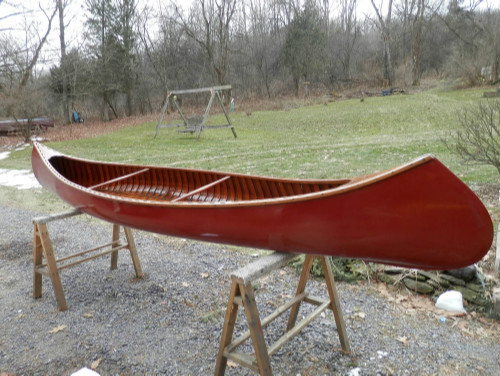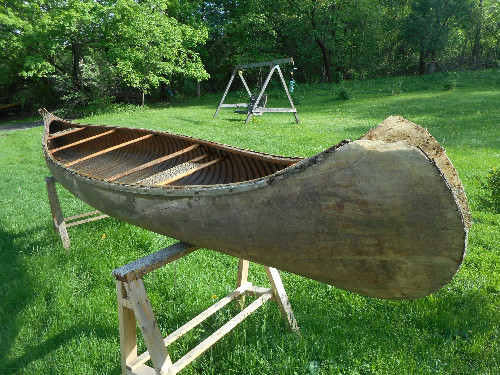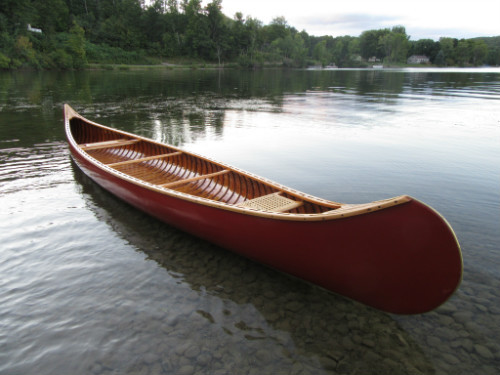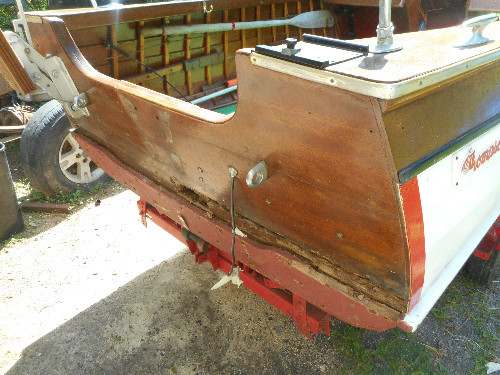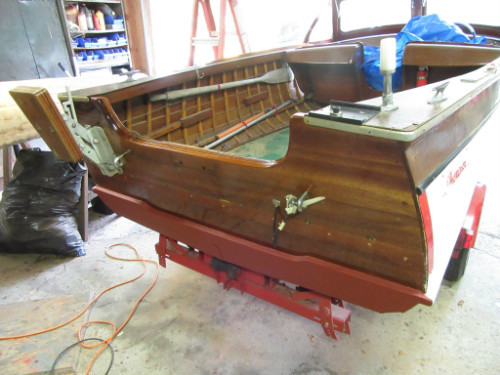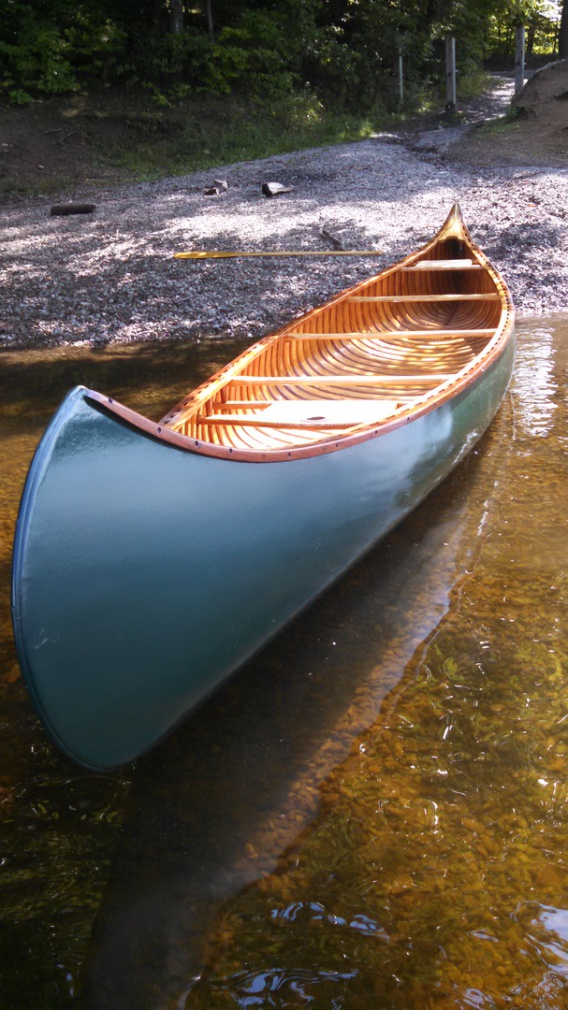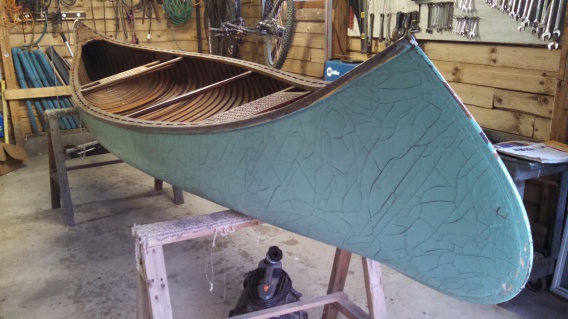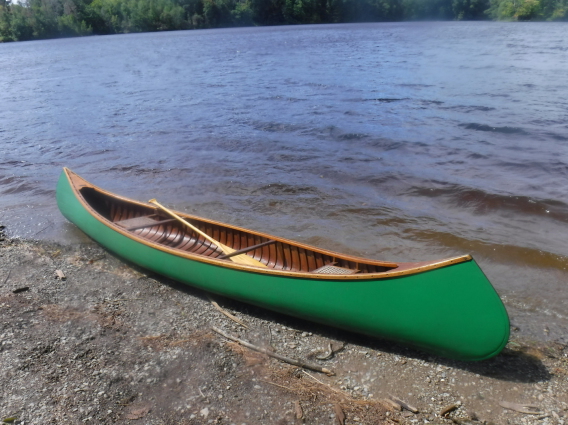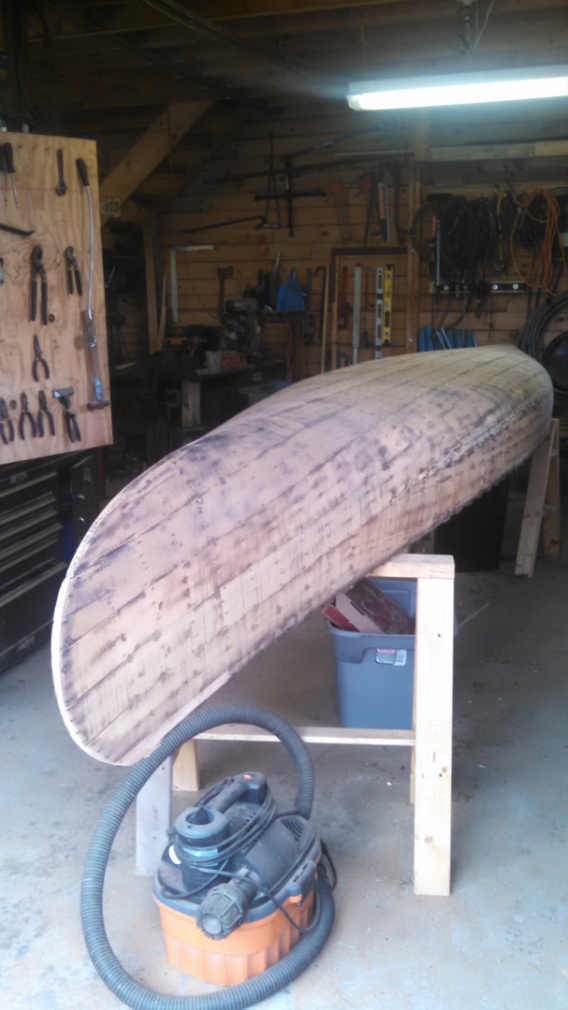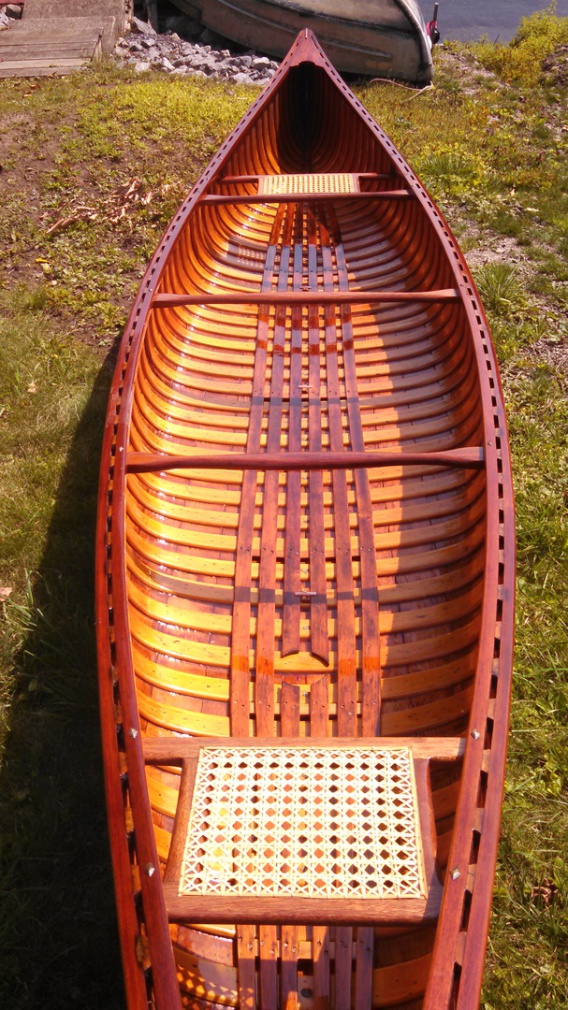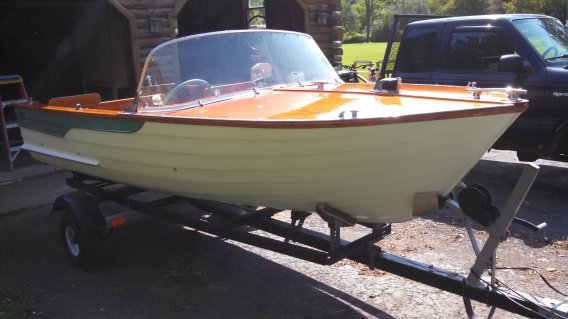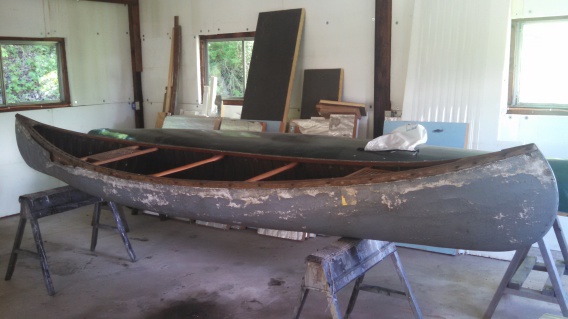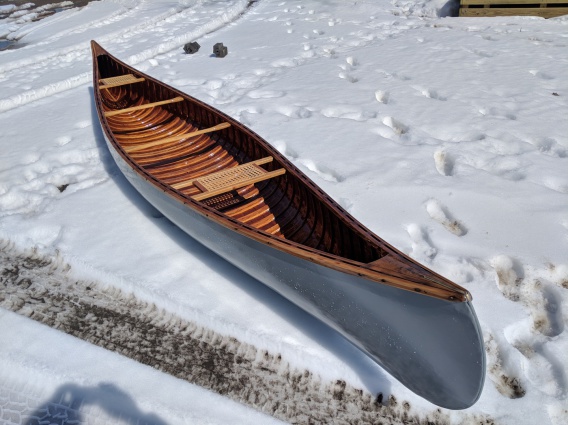Canoe Restoration
With some time, effort, and the right materials, just about any old, worn out wood canvas canoe can be restored to beautiful, functional, like-new condition. This page is meant to serve as
a showcase of restorations the shop has completed and show how your old, worn out canoe or other small wooden craft can be brought back to better than brand new with the right time, skill, and
effort.
The cedar canvas building style lends itself readily to restoration. Individual pieces that have failed can be replaced to bring the canoe back up to its original strength. Replacing old canvas is actually quite simple. A beat up interior can be stripped, sanded and varnished again to return it to its original, glowing appearance. No repair job is too small and no restoration too complicated, unless the canoe is so far gone as to be seriously out of shape and beyond saving, which is rare.
Restoration of an old canoe allows the legacy of the wood canvas canoe to continue and preserves the memories an old canoe can hold for the paddler and their family. The aged canoe once set aside from regular use can be made functional once again, allowing the joys and memories made from exploring the waterways in a well crafted hand made canoe to be passed down to the next generation and onward.
Restorations to Date
This is a 16 foot long canoe made by the Old Town Canoe Company of Old Town, Maine. It was not originally fitted out with seats, as was the native style. This restoration required new ribs, new planking, new decks and outer gunwales, stem and gunwale tip repair, new canvas, and a refinished interior.
Before:
This is an old style 17 foot long canoe, built by the J.R. Robertson Canoe Company of Auburndale, Massachusetts. This company was instrumental in introducing thousands of people to canoeing in a recreational sense. Prior to the early 20th century, canoes were used largely for professional trapping, guiding, timber surveying, trading, and wilderness exploration. This canoe is complete with mahogany seats and thwarts, traditional closed gunwales, and hand caned seats.
Before:
After:
A canoe made in the style of the small, lightweight canoes used by trappers and fishermen to pack into inland ponds in the heart of the north country. Like all restorations, this canoe required new canvas and new varnish, but only of couple ribs and some planking, in addition to re-caning the seats.
Before:
Like the Fifty Pounder above, this canoe was in pretty good shape considering its age. It originally had sponsons, or the air chambers on the sides to prevent capsizing, but these were removed during the restoration on request of the customer to make the canoe lighter and easier to handle. Common with many older canoes, the ends of this canoe were rotten and new ends had to be spliced onto the stems, outer gunwales, and inner gunwales. New decks were also required to make the ends of the canoe whole again.
Before:
This kayak consists of a lightweight poplar and steel frame covered with canvas and was built from a kit back in the day by a customer's grandfather. The frame was in surprisingly good shape, and most of the restoration was in hand stretching the canvas sheathing over the shape of the frame.
Before:
Thompson was once the largest producer of outboard motor boats in the world, but also made a few models of canoes, many examples of which survive to this day. The Hiawatha is unique in its design in that is has full width half-ribs with the ends of the half-ribs covered by longitudinal stringers, making a flat, solid floor for the base of the canoe. This particular canoe was very sound structurally, evidence that it was either used sparingly, or who ever used it was a good paddler.
Before:
Another Classic Old Town canoe in for complete restoration. The longer 18' and above canoes have been largely forgotten in favor of shorter 16'-14' boats with the belief that shorter boats are easier to handle. Contrary to that popular belief, the extra length greatly reduces the draft of the canoe, enabling it to float in shallower water where its shorter counterparts might be left scraping the bottom. It allows for greater paddling speeds with either a solo or tandem paddlers, and extra buoyancy to hold one or two of their friends. The restoration on this canoe was extensive and laborious, and the result is a revived beauty that will stand up to many more years out in the elements that is was originally intended to navigate.
Before:
Another boat from the Thompson Company, this is the first full size power boat that the shop has worked on. Built nearby in Cortland, NY, in 1960, this very solid boat is in great condition, and just needed some attention to the transom to be fully functional again. The rotted lower half was replaced with new mahogany, which was glued and screwed together to the original upper half to create a strong, watertight panel to mount the motor to.
Before:
15' Huron Canoe
This 15' wood canvas canoe from Canada needed new canvas and refreshed varnish to get it back on the water. This canoe built by Bastien Brothers is a typical example of a "Huron" canoe, from a number of builders in Quebec. Typically not built to the highest standards of quality or finish, these boats are prime examples of the canoe as a purely functional craft for backwoods use. While not as "fancy" as an Old Town or Morris canoe, these canoes are well loved by many as excellent paddling craft lacking in unecessary frills or building expense.
Before:
After:
Cedarwood Freighter
Built by Cedarwood Canoes of New Bunswick, Canada. This company was owned and operated by Carl Jones, the shop manager for the famous Chestnut Canoe Company at the time of its closing. The construction on this boat is superb, with care and skill evident throughout. Built in the wood canvas style, this boat is much larger than most canoes and able to carry a very heavy load comfortably. This particular canoe needed only new canvas and paint to be made functional again.
Before:
After:
1958 Old Town OTCA
This canoe is an Old Town OTCA from 1958, One of Old Town's most common models. This canoe was brought back to new condition by stripping, sanding, and revarnishing all the woodwork, replacing several ribs, recaning the seats, and new canvas and paint for the exterior.
Before:
After:
Thompson Indian Recanvas
This canoe is a true familty heirloom. It was purchased for the Customer's Mother to use when she was young at the family's summer home on a small lake in Upstate New York. The Thompson Brothers Boat Company started in Wisconsin and eventually opened a factory in Cortland, NY, to get a foothold in the northeast's booming boat market. They were a prolific producer of lapstrake outboard boats, but had a few canoe models that were very nicely built. This canoe came in with its original canvas from 1936 still intact, and needed only new canvas and new varnish on the gunwales to get it back good shape for the lake. Several years after finishing this canoe, the owners contacted me saying that they were unable to use the canoe easily due to its weight and that nobody else in the family was interested in taking ownership and care of this very well preserved canoe. I offered to buy the canoe back for the price of the restoration in order to continue its legacy and enjoy paddling it often around my home in Upstate NY.
Before:
After:
1952 Old Town Guide
This Old Town Guide canoe came in for a full restoration. Built in AA grade with mahogany gunwales and trim, this canoe also included a removable floor rack that was refinished along with the canoe.
Before:
After:
Wooden Runabout Restoration
This boat did not need any woodworking repairs, but required a decent amount of disassembly, cleaning, sanding, and refinishing to update the paint and varnish work.
Before:
After:
Chestnut Canoe Restoration
This was a fairly basic restoration including new canvas, stripping and revarnishing the wood work, new fasteners and hardware, and a couple of new ribs.
Before:
After:

